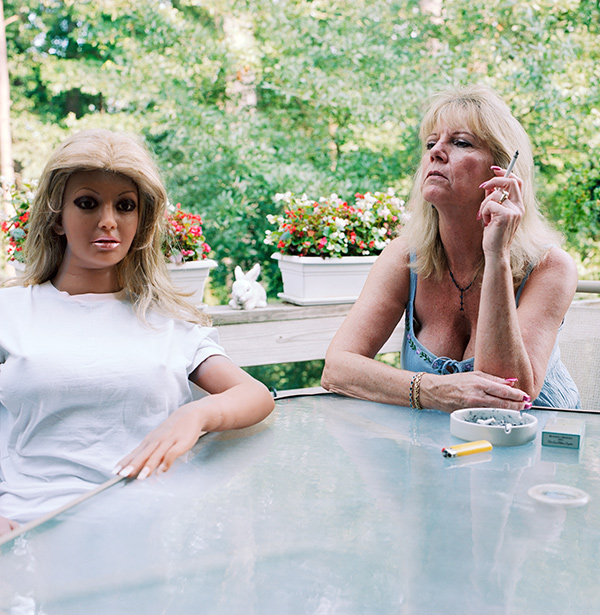A Surrogate for Love
Artists Jamie Diamond and Elena Dorfman picture the intimate familial, and at times romantic and sexual relationships between people and synthetic human dolls. On the occasion of their joint exhibition in Milan, Surrogati. Un amore ideale, they spoke with curator Melissa Harris about stigma, the doll community, and redefining love.
Melissa Harris: Based on my conversations with some of your respective subjects, they seem to accumulate, to embrace many dolls in their lives. Where does the collecting impulse play into this, do you think?
Elena Dorfman: I think it’s about making a community, a family. And, in the case of the people I photograph, also about attaining a sexual partner or partners.
Jamie Diamond: When I say, “collecting,” I think that word is being appropriated from history—from the idea of doll collecting. It’s changed considerably within this community: It’s the creation and gathering together of surrogates. Take for example the terminology of “portrait babies”— dolls made based on old photographs of a childhood past. Essentially when a child has died—that’s a big part of the idea of surrogacy. Or there are women who can’t have any more children because of illness or age, or women who for various reasons can never have children.
Dorfman: In the doll community I focus on, they were generally surrogates for flesh and blood women that for whatever reason eluded the men. They were also fantasy women and muses. In the case of the image of the doll in the church, Rob was writing a novel, and Lily was his muse. His novel had to do with the church and spirituality, so I asked if he was willing to take her to church. That was always my process—I asked the men what they did with the dolls on a day-to-day basis, or what they would like to do with them. Taking her to church, however, was nearly a disaster. These dolls are very heavy, and complicated and cumbersome to move, so physically navigating her into a house of worship was challenging.
Harris: Were there other people in the church at the time?
Dorfman: Yes, there were.
Harris: Did anybody know this was a part of his life?
Dorfman: Absolutely not. But he was willing to take her out of the house in order to try to overcome the stigma that doll owners face, to move beyond the walls of his house.
Harris: Jamie, do those with reborn dolls feel similarly stigmatized?
Diamond: Outsiders make assumptions and may think that these women are crazy. But I’ve never met a woman in this community who thinks their doll is real, regardless of her behavior. The women might treat it as if it’s real, but they know the difference. In fact, most of the women I’ve met are kind, generous, nurturing, and very much in touch with reality. There is genuine feeling here, far beyond fantasy or role-play.
Harris: There seems to be a certain amount of common ground shared by your two projects, synergy between their emotional and psychological underpinnings. Many of your subjects I spoke with made an analogy to having a pet. We use that word “anthropomorphize”—the way people converse with or refer to animals and their emotional lives as if they are human, but even in these instances, they’re still interacting with a living creature. How does all this happen with synthetic creatures? How do we bestow human qualities, a type of life itself, on the inorganic?
Dorfman: In the case of the sex dolls, they are so lifelike that they fall into the uncanny valley. My experience was that in order to live with a silicone surrogate over an extended period of time, to devote so much of your life, energy, and finances to her (these dolls are expensive), she has to be given a life story, which nearly every man conjured.
Diamond: It’s the same for my subjects on so many levels. What’s interesting to me is while making the dolls, I knew I was done when I had that visceral response … when I felt the urge to hold it. Something gets triggered. It’s hard to articulate because it’s just something that you feel so deeply within yourself, that it feels real.
Dorfman: But this fantasy is also a reflection of technology and artistry. The dolls look so realistic it makes it easier for them to “pass” as real women. This wasn’t so true when I began nearly twenty years ago. The world we live in today, where the norms of beauty are shifting and the demand that women stay eternally youthful becomes increasingly urgent—this, combined with medical and technological advances, and more sophisticated techniques applied to the creation of plastic women, blur the line between flesh and silicone even more.
Harris: What’s interesting to me about both of your projects is that they challenge so many preconceptions about sex and love and relationships, family and motherhood. They are remarkably open-ended emotionally and psychologically.
Dorfman: For the most part, the doll owners I worked with had a certain level of emotional depth, self-awareness, and self-knowledge. I was often surprised and constantly rubbing up against my own ideas of what constitutes love—and what kind of person lives with a love doll as his or her domestic partner. My preconceptions were regularly shattered.
Harris: Do you consider these projects documentary in nature?
Dorfman: Yes. For this series, I documented the domestic lives of men and women who live with life-sized, anatomically correct, sex dolls.
Diamond: My work has always been rooted in fiction while examining the disparity between image and reality. I use photography and staged intimacy as a vehicle to question existing values regarding inherited social and gender expectations. “Forever Mothers” is interesting for me in that there is a level of reality that never existed before in my work. Everything prior to this was very much a construction that I was producing for the camera.
Harris: Let’s talk about the history of the arts and literature—dolls are omnipresent. Why is that? There’s something about not being quite sure what you’re looking at, that is fascinating. Both of you, I know, have various references, visual references—not even necessarily for your own work, but in terms of how you contextualize your subject.
Diamond: Think of Morton Bartlett. Part of what I find interesting is his fetishization of the doll. He’s basing them on children, but there’s something maybe a little perverse about how he’s representing them. But his obsession—the fact that he’s sculpting these anatomically complete dolls, dressing them and then photographing them (although sometimes they are naked in the photographs)—is fascinating. You don’t know exactly what you are looking at.
Dorfman: While making “Still Lovers,” I became aware of the role that automatons and dolls have played throughout mythology and art history. Of particular intrigue was Thomas Edison’s Phonograph Doll, from 1877—a twenty-two-inch doll that played a single nursery rhyme; Oskar Kokoshka’s 1918 stuffed replica of Alma, his estranged lover; the contorted, life-sized pubescent figures and photographs by Hans Bellmer; and, the myths of Pygmalion, and Pandora—the perfect woman created by the Gods, with the purpose of destroying mankind. Women’s roles have always been complicated, as they embody both the expression of and end to Paradise.
Diamond: Regarding our projects, there are parallel narratives here that are intriguing, each involving genuine human emotion, but within a shifting set of parameters, as the dolls become more and more lifelike, and what they represent shifts.
Dorfman: At first glance, it may be easy for viewers to characterize our subjects as peculiar, or in some way deviant. But, while their chosen lifestyles or hobbies might be out of the ordinary, they pose myriad and fascinating questions about the intersection of fantasy and reality, and shed light on the human condition now—and in the future.
This interview is excerpted from Surrogati: Un Amore Ideale (Surrogate: A Love Ideal), in Quaderno #23, Fondazione Prada, Milan, 2019, in conjunction with an exhibition on view at Fondazione Prada’s Osservatorio, in Galleria Vittorio Emanuele II, Milan, from February 21–July 22, 2019.
































